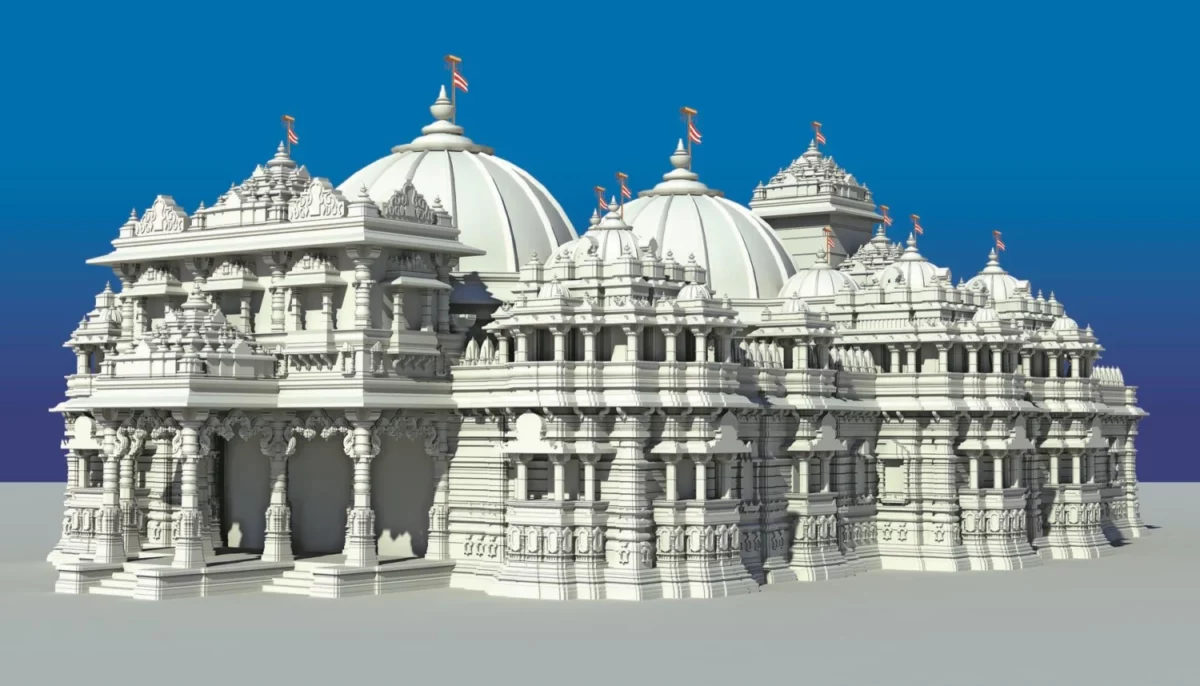Contents
- 1 Swaminarayan Temples and Nagara Influence:
- 2 Intricate Carvings and Sculptures
- 3 Grand Gateways and Towers
- 4 The Domes of Swaminarayan Temples
- 5 Abhishek Mandap
- 6 Modern Innovations in Temple Architecture
- 7 The Spiritual Experience within the Temples
- 8 Ritualistic and Functional Design
- 9 Preservation and Maintenance of Heritage
- 10 Global Impact of Swaminarayan Temples
- 11 Influence on Contemporary Architecture
- 12 Sustainability and Eco-Friendliness
- 13 FAQs
Swaminarayan Temples, also known as Akshardham Temples, are a magnificent example of architectural brilliance that beautifully blends tradition with modernity. These temples are not only spiritual centers but also architectural marvels that captivate visitors with their intricate designs, breathtaking sculptures, and spiritual ambience. In this article, we’ll delve into the captivating architecture of Swaminarayan Temples in India, exploring the elements that make them unique and awe-inspiring.
Swaminarayan Temples are dedicated to Bhagwan Swaminarayan, the founder of the Swaminarayan Sampradaya. The architecture of these temples reflects the spiritual philosophy of purity, divinity, and devotion. With their origins dating back to the early 19th century, these temples have a rich history that has evolved along with India’s cultural landscape.
Mandirs within the Swaminarayan tradition are all of the Nagara style.
Swaminarayan Temples and Nagara Influence:
Swaminarayan Temples, while drawing from various architectural styles, often incorporate elements of the Nagara style to create a unique blend of tradition and innovation. These temples are characterized by their grand entrance gates, intricate carvings, and majestic shikhara, all of which show the influence of the Nagara architectural style.
Swaminarayan Temples retain the Nagara style’s emphasis on symmetry and spirituality, and they often feature multiple shikharas that create a visually captivating skyline. The central spire of the temple, along with smaller surrounding spires, reflects the traditional Nagara architectural concept.
The carvings on Swaminarayan Temples often depict scenes from Hindu mythology and the life of Bhagwan Swaminarayan. These intricate carvings are reminiscent of the attention to detail found in Nagara temples.
Nagara Architectural Style:
The Nagara style of temple architecture is primarily associated with northern India. It is known for its tower-like spires, called shikhara, which rise prominently above the temple structure. The shikhara is often curvilinear and resembles a mountain peak or a cosmic mountain, symbolizing the abode of gods. The Nagara temples are also characterized by their square or rectangular sanctum at the base, leading to a curvilinear superstructure.
Key Features of the Nagara Style:
- Shikhara: The towering and ornate shikhara is a hallmark of Nagara temples. Its intricate details and decorative elements make it a focal point of the temple’s architecture.
- Mandapa: The temple often has a pillared hall or mandapa in front of the sanctum. This space is used for congregational gatherings and rituals.
- Garbhagriha: This is the innermost sanctum, where the main deity is enshrined. It is typically square or rectangular in shape and holds great spiritual significance.
- Amalaka: A circular stone disk placed atop the shikhara, representing the sun or cosmic energy.
- Vimana: The pyramidal roof above the sanctum, which tapers as it rises, creating an elegant and symbolic ascent towards the divine.
Intricate Carvings and Sculptures
The intricate carvings of Swaminarayan Temples are a testament to the rich artistic heritage, devotion, and attention to detail that define these magnificent structures. These carvings are not just decorative elements; they are deeply symbolic, telling stories of mythology, spirituality, and the life of Bhagwan Swaminarayan himself. Let’s delve into the significance and characteristics of the carvings in Swaminarayan Temples:
Symbolism and Spiritual Significance:
- Narrative Depictions: The carvings often depict scenes from Hindu scriptures, including episodes from the Ramayana, Mahabharata, and other mythological texts. These carvings serve as visual narratives, bringing to life the stories of gods, heroes, and moral lessons.
- Divine Beings: Carvings of deities, celestial beings, and divine symbols adorn the walls and pillars. These representations connect worshippers to the divine presence and create an atmosphere of reverence.
- Spiritual Teaching: The carvings also convey the spiritual teachings and philosophy of Bhagwan Swaminarayan. They illustrate his messages of devotion, morality, and the path to salvation.


Characteristics of Carvings in Swaminarayan Temples:
- Intricacy and Detail: The carvings are characterized by their intricate and meticulous craftsmanship. Every figure, motif, and pattern is intricately carved, showcasing the skills of artisans.
- Variety of Themes: The carvings cover a wide range of themes, from epic stories to devotional moments, intricate floral patterns, and depictions of nature. This variety adds depth to the visual narrative of the temple.
- Temple Architecture: Carvings also incorporate architectural elements such as pillars, arches, and domes. This blurs the line between art and architecture, enhancing the overall visual experience.
- Geometric Precision: Many carvings adhere to strict geometric proportions, contributing to the overall symmetry and balance of the temple’s design.
- Reflecting Cultural Diversity: Swaminarayan Temples often incorporate carvings that reflect the cultural diversity of the regions they are located in. This inclusivity adds to the temple’s universal appeal.
Connection to Spiritual Experience:
The carvings within Swaminarayan Temples enhance the spiritual experience of visitors and devotees. They serve as a means of meditation, contemplation, and connection with the divine. The intricate details encourage observers to reflect on the profound messages embedded within the stories and teachings.
Cultural and Artistic Legacy:
The carvings also play a role in preserving and promoting India’s rich artistic heritage. They showcase the skills of traditional craftsmen and contribute to the continuation of traditional techniques, ensuring that these art forms are passed down to future generations.
Grand Gateways and Towers

The towering gateways, often referred to as “Torans,” welcome visitors with their ornate design. The central spires, or shikhars, rise elegantly, symbolizing the connection between the earthly and the divine.
Harmonious Symmetry
Swaminarayan Temples are known for their precise geometric proportions and symmetrical layouts. This symmetry is believed to create a sense of balance and tranquility within the temple premises.
Use of High-Quality Materials
The construction of these temples involves the use of premium materials, ensuring longevity and timeless beauty. Intricate marble work and vibrant pigments add to the visual appeal.
Reflecting Spiritual Symbolism
The architecture incorporates spiritual symbolism. For instance, the nine domes in some temples represent the nine forms of devotion in Hinduism, fostering a deeper spiritual connection.
The Domes of Swaminarayan Temples
The domes of Swaminarayan Temples play a significant role in enhancing the architectural grandeur and spiritual ambiance of these sacred structures. These domes are not only aesthetically pleasing but also hold symbolic and spiritual meanings that contribute to the overall experience of visitors and devotees. Let’s explore the significance and characteristics of the domes in Swaminarayan Temples:
Symbolism and Spiritual Significance:
- Cosmic Representation: The domes in Swaminarayan Temples often symbolize the cosmic universe and the celestial abode of gods. They aim to create a sense of connection between the earthly and the divine realms.
- Spiritual Ascent: The upward-reaching shape of the dome signifies the spiritual journey of devotees towards higher consciousness and enlightenment. It encourages worshippers to lift their thoughts and aspirations to higher spiritual planes.
- Unity and Wholeness: The dome’s circular shape represents unity and the cyclical nature of life. It reflects the idea of oneness and the interconnectedness of all living beings.

Characteristics of Domes in Swaminarayan Temples:
- Intricate Detailing: The domes are often adorned with intricate carvings, sculptures, and motifs that depict mythological narratives, deities, and divine beings. These details add to the visual splendor of the temple.
- Use of Materials: Domes in Swaminarayan Temples are crafted using high-quality materials such as marble, stone, or even metal. The choice of materials contributes to the durability and timeless elegance of the domes.
- Harmonious Proportions: The size and proportions of the dome are meticulously designed to maintain harmony with the rest of the temple’s architecture. This attention to proportion ensures a balanced and visually appealing structure.
- Light and Shadow Play: The curvature of the dome allows for interesting light and shadow play, especially during different times of the day. This adds to the mystique and aura of the temple environment.
- Spiritual Symbolism: Some temples incorporate specific symbols or geometrical patterns on the domes that hold spiritual significance. These symbols often represent aspects of the temple’s deity or the teachings of the faith.
Abhishek Mandap
The Abhishek Mandap holds a special place within Swaminarayan Temples, serving as a sacred space where devotees can participate in various rituals and ceremonies, particularly the abhishek ritual. This area plays a crucial role in enhancing the spiritual experience of worshippers by providing a dedicated place for offerings, prayers, and connections with the divine. Let’s explore the significance and characteristics of the Abhishek Mandap:


Purpose and Significance:
- Abhishek Ritual: The Abhishek Mandap is primarily used for the abhishek ritual, which involves the ceremonial bathing of the temple’s deity with various substances such as milk, honey, water, and fragrant oils. This ritual symbolizes purification, devotion, and the offering of one’s devotion to the divine.
- Devotional Experience: The Abhishek Mandap offers a unique opportunity for devotees to actively participate in the temple’s rituals. This involvement fosters a deeper sense of connection and spirituality among worshippers.
- Purification and Blessings: The abhishek ritual is believed to cleanse the deity and bestow blessings upon the devotees. It is a way of seeking divine favor, protection, and spiritual growth.
Characteristics of the Abhishek Mandap:
- Design and Layout: The Abhishek Mandap is often designed with elements that facilitate the abhishek ritual. It may feature a central platform or pedestal where the deity is placed during the ceremony.
- Water Drainage: To accommodate the ritualistic pouring of liquids, the Abhishek Mandap is equipped with proper drainage systems that direct the offerings away from the deity and the temple premises.
- Decorative Elements: The mandap may be adorned with intricate carvings, sculptures, and decorative motifs that reflect the temple’s architectural style and add to the sanctity of the space.
- Devotional Atmosphere: The ambiance of the Abhishek Mandap is carefully curated to create a serene and devotional atmosphere. Soft lighting, fragrant incense, and soothing music often enhance the overall experience.
Ritual Process:
- Preparation: Before the abhishek ritual, the deity is adorned with fine clothes, jewelry, and garlands. Devotees often bring offerings such as flowers, fruits, and sweets.
- Pouring of Offerings: During the abhishek ritual, a priest or devotee pours various substances over the deity while reciting prayers and mantras. Each substance has a symbolic meaning, representing different aspects of divine blessings.
- Devotee Participation: In some cases, devotees may have the opportunity to personally participate in the abhishek ritual by pouring offerings onto the deity. This active involvement adds to the spiritual experience.
Spiritual Connection:
The Abhishek Mandap fosters a direct and personal connection between devotees and the divine. The act of participating in the abhishek ritual allows worshippers to express their devotion, gratitude, and aspirations in a tangible and meaningful way.
Modern Innovations in Temple Architecture
While rooted in tradition, Swaminarayan Temples have also embraced modern architectural concepts. Incorporating contemporary materials and technologies, these temples stand as a harmonious blend of the old and the new.
The Spiritual Experience within the Temples
The architecture of Swaminarayan Temples is intended to elevate the spiritual experience of devotees. The play of light and shadow, the serene ambience, and the divine imagery create an atmosphere conducive to prayer and meditation.
Ritualistic and Functional Design
The temples’ architecture also considers the practical aspects of rituals and gatherings. The inner sanctums, prayer halls, and assembly areas are designed to accommodate large congregations while maintaining the sanctity of the space.
Preservation and Maintenance of Heritage
Efforts to preserve the architectural heritage are ongoing. Restoration projects, maintenance initiatives, and documentation ensure that the temples’ intricate details and historical significance are safeguarded for future generations.
Global Impact of Swaminarayan Temples
The influence of Swaminarayan Temples extends beyond India. These architectural wonders have inspired the construction of similar temples around the world, spreading the essence of Indian spirituality and craftsmanship.
Influence on Contemporary Architecture
The architectural principles of Swaminarayan Temples have influenced modern architects. Concepts of symmetry, spiritual symbolism, and attention to detail have found their way into contemporary designs.
Sustainability and Eco-Friendliness
In recent years, there’s been a focus on making temple architecture more sustainable. Incorporating renewable energy sources, water harvesting techniques, and eco-friendly materials showcase a commitment to environmental consciousness.
FAQs
Swaminarayan Temples are distinct for their intricate marble work, use of vibrant colors, and meticulous detailing that sets them apart from other traditional temple designs.
Yes, the consecration of these temples involves intricate rituals performed by spiritual leaders, architects, and artisans to infuse divine energy into the structure.
While there are overarching design principles, individual branches of Swaminarayan Temples often have some flexibility to adapt their architecture to local contexts.
Architects and artisans carefully balance the use of modern technologies, like 3D modeling and restoration tools, with traditional craftsmanship to ensure authenticity while addressing practical concerns.












